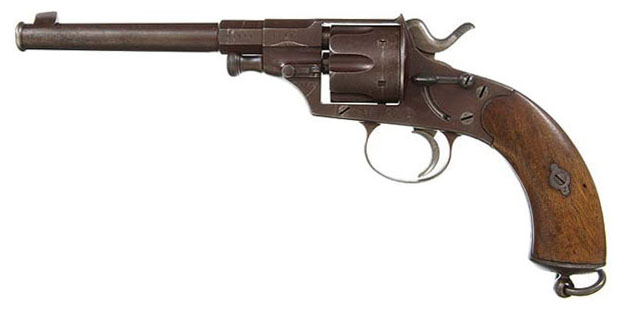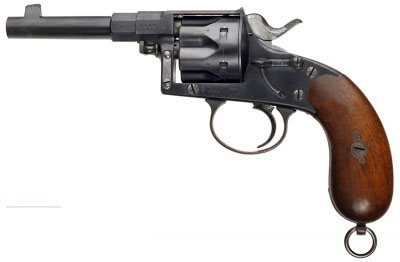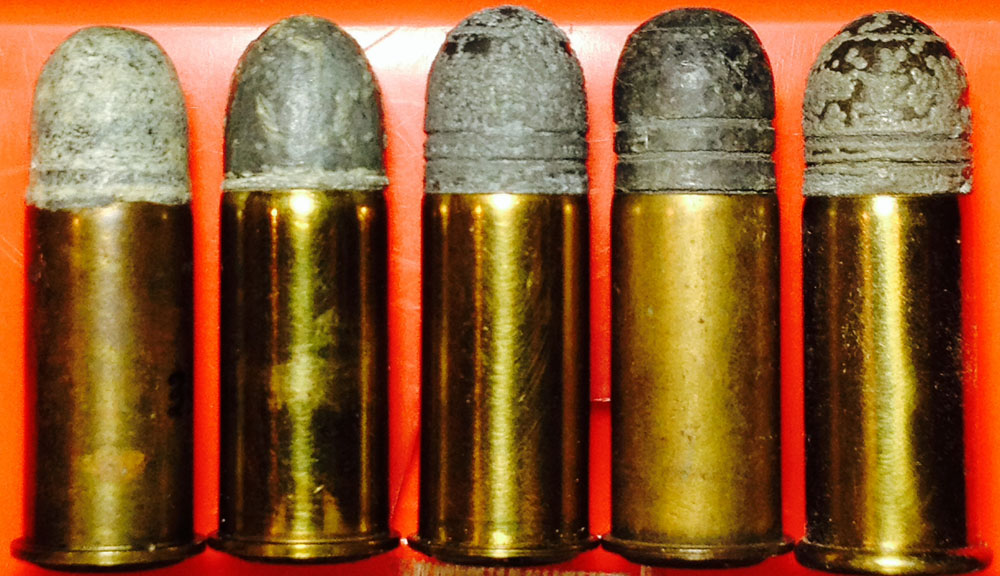|
THE CARTRIDGE COLLECTOR'S EXCHANGE |
|
Home of the Old Ammo Guy's Virtual
Cartridge Trading Table
Picture Page June 2016 Please note: Unless otherwise indicated, the pictures on this web site are my property, and should not be used by anyone without my permission. The Cartridges of the 19th Century European Big-Bore Revolvers
PART 1: 10.6 x 25mm German Ordnance The first repeating handgun adopted by the German (Prussian) army was the
1879 Reichsrevolver,
The cartridge used in the Reichsrevolvers was the 10.6 x 25mm rimmed, which was fairly comparable dimension-wise to the .44 Smith & Wesson Russian cartridge, but didn't quite match it's ballistics. Dimensions: Bullet: .423"- .433" Case neck: .444"-.452" Case head: .446"-.454" Rim: .500"-.515" Case length: .964"-.980" Cases are typically found with a raised head referred to as a 'Mauser A base', but can also have a flat head. Those with the raised head tend to be head stamped, while the flat head type are usually not head stamped, and are thought to be commercial rather than military rounds. Production of the cartridge in Germany continued until the end of WW1.
.
. Shown above is an assortment of the 10.6 German head stamps from my collection, four of which have the raised head with raised lettering in the head stamps and the last one having a flat head and lacking a head stamp. The first two are the proprietary head stamps of Georg Egestorff of Linden (Hannover), Germany (G. EGESTORFF + LINDEN b/H +) and Wilhelm Lorenz of Karlsruhe, Germany (LORENZ + KARLSRUHE +). The next two show the four position military style head stamp of Koenigliche Munitionsfabrik Spandau near Berlin, with the dates of July 1897 and August 1916. The maker and country of origin of the fifth cartridge can't be determined, but it was likely made in Germany and is possibly World War 2 production. The five cartridges are shown in the next photo approximately full size and in the same order as their head stamps were shown above.
. . . .
.
.Sources: Photos of German Model 1879 and 1883 revolvers from the Internet Movie Firearms Database-www.imfdb.org . . .
|

 a
utilitarian revolver that was designed by a committee tasked with
developing a modern weapon to replace the single shot pistols in use at the
time. Oddly, this committee apparently worked in a vacuum, with little
notice of (or interest in) the technical advancements in firearms that were
readily available at the time. For example, the Smith & Wesson Russian model
revolver, with it's top-break frame and automatic ejection, had been
introduced in 1871 and by 1878 over 165,000 had been produced, most of those
on contract to Russia, Turkey and Japan. Approximately 25,000 of the Russian
Model revolvers were sold commercially to anyone wishing to purchase one.
Yet the Model 1878 Reichsrevolver used a solid frame and reloading it
required the cylinder to be removed and the fired cases to be extracted
individually using the cylinder pin as an extraction punch. In the heat of
battle, this cumbersome process for reloading probably resulted in more than
a few cylinders of cylinder pins being dropped and rendering the revolver
useless for any defensive purpose other than perhaps throwing. In addition,
while it was a single action design requiring the hammer to be pulled
back manually to fire, it was fitted with a safety lever on the frame.
a
utilitarian revolver that was designed by a committee tasked with
developing a modern weapon to replace the single shot pistols in use at the
time. Oddly, this committee apparently worked in a vacuum, with little
notice of (or interest in) the technical advancements in firearms that were
readily available at the time. For example, the Smith & Wesson Russian model
revolver, with it's top-break frame and automatic ejection, had been
introduced in 1871 and by 1878 over 165,000 had been produced, most of those
on contract to Russia, Turkey and Japan. Approximately 25,000 of the Russian
Model revolvers were sold commercially to anyone wishing to purchase one.
Yet the Model 1878 Reichsrevolver used a solid frame and reloading it
required the cylinder to be removed and the fired cases to be extracted
individually using the cylinder pin as an extraction punch. In the heat of
battle, this cumbersome process for reloading probably resulted in more than
a few cylinders of cylinder pins being dropped and rendering the revolver
useless for any defensive purpose other than perhaps throwing. In addition,
while it was a single action design requiring the hammer to be pulled
back manually to fire, it was fitted with a safety lever on the frame. In 1883, a smaller version Reichsrevolver was introduced; while it had a
shorter barrel and a more rounded butt than the earlier version, it utilized
the same antiquated design. Both models of the Reichsrevolver were the
standard issue German army handgun until they were replaced in 1908 by the
Parabellum (Luger) pistol. They were put back into service by the German
army during World War 1 and were issued to the German home guard in
World War 2.
In 1883, a smaller version Reichsrevolver was introduced; while it had a
shorter barrel and a more rounded butt than the earlier version, it utilized
the same antiquated design. Both models of the Reichsrevolver were the
standard issue German army handgun until they were replaced in 1908 by the
Parabellum (Luger) pistol. They were put back into service by the German
army during World War 1 and were issued to the German home guard in
World War 2. 
